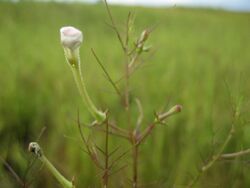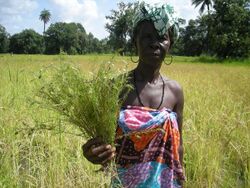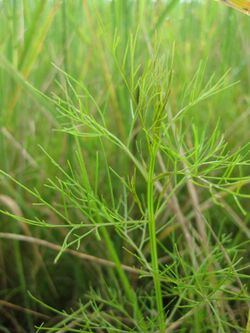Biology:Rhamphicarpa fistulosa
| Rhamphicarpa fistulosa | |
|---|---|

| |
| Flower of Rhamphicarpa fistulosa | |
| Scientific classification | |
| Kingdom: | Plantae |
| Clade: | Tracheophytes |
| Clade: | Angiosperms |
| Clade: | Eudicots |
| Clade: | Asterids |
| Order: | Lamiales |
| Family: | Orobanchaceae |
| Genus: | Rhamphicarpa |
| Species: | R. fistulosa
|
| Binomial name | |
| Rhamphicarpa fistulosa (Hochst.) Benth.
| |
Rhamphicarpa fistulosa (common name: rice vampireweed) is a flowering plant species in the family Orobanchaceae (formerly in the family Scrophulariaceae)[1] - and the genus Rhamphicarpa.[2][3][4][5][6] The plant is pale-green but can turn reddish towards maturity. It has needle-like leaves and white flowers with long corolla tubes.[7] The flowers only open after sunset and are supposedly pollinated by night moths.[8] The plant has a broad distribution in Africa (from Guinea to Madagascar and from Sudan to South Africa) and can also be found in New Guinea and northern Australia.[6]
Rhamphicarpa fistulosa is an annual facultative hemi-parasitic forb species.[8] It is a very widespread species in seasonally flooded wetlands in tropical and sub-tropical Africa, and it is increasingly important as a parasitic weeds in rain-fed lowland rice systems in Africa,[9][10][11][12][13] where yield losses of more than 60% are typically reported.[14] It is particularly a problem in rice fields prone to temporary, uncontrolled flooding.[14][15] Management strategies against Rhamphicarpa fistulosa are limited;[16][17] hand-weeding, permanent flooding, fertilizer applications and the use of herbicides are currently known, effective control measures.[11][18] In addition, a number of high-yielding, resistance and tolerant rice varieties has recently been identified.[19]
A team of researchers from the Africa Rice Center (AfricaRice),[20] Wageningen University, FAO and the national research centers of Tanzania (MARI), Cote d'Ivoire (CNRA) and Benin (INRAB), investigates the importance of this species as a parasitic weed to rice [9] and tries to elucidate its biology, ecology and host damage mechanisms [21][22] and to develop, with participating farmers, management strategies. The economic and social determinants [23] and impact is also studied and national extension and crop protection systems are analyzed [24][25][26] with the aim to identify constraints and challenges for the effective control and prevention of invasive pests [27] such as Rhamphicarpa fistulosa. The project, called PARASITE [28] is funded by the Netherlands Organisation for Scientific Research - Science for Global Development and receives additional financial support through the CGIAR[29] Research Program on Climate Change, Agriculture and Food Security (CCAFS).[30] The PARASITE project (www.parasite-project.org) has so far resulted in 10 published SCI journal papers.
Other groups working on Rhamphicarpa fistulosa: Laboratory of Applied Ecology, Department of Natural Research Management, Faculty of Agronomic Sciences, University of Abomey-Calavi, P.O. Box 526, Cotonou, Benin; AgroSup Dijon, UMR 1347 Agro-ecologie Pôle EcolDur, 17 rue Sully, BP 86510, 21065 Dijon cedex, France.
References
- ↑ Olmstead RG, DePamphilis CW, Wolfe AD, Young ND, Elisons WJ, Reeves PA, 2001. Disintegration of the Scrophulariaceae. American Journal of Botany 88, 348-361.
- ↑ Bentham G, 1835. Synopsis of the Buchnereae, a tribe of Scrophulariaceae. Companion to the Botanical Magazine 1, 356-384.
- ↑ Bentham G, 1846. Ordo CXLII. Scrophulariaceae, In: De Candolle, A. (Ed.), Prodomus systematis naturalis regni vegetabilis. Paris, pp. 186-586.
- ↑ Hochstetter CHF, 1841. Plantarum nubicarum nova genera. Flora 24, 369-384.
- ↑ Engler A, 1895. Die Pflantzenwelt Ost-Afrikas und der Nachbargebiete. Deutsch Ost-Afrika 5, 1-433.
- ↑ 6.0 6.1 Hansen OJ, 1975. The genus Rhamphicarpa Benth. emend. Engl. (Scrophulariaceae). A taxonomic revision. Botanisk Tidsskrift 70, 103-125.
- ↑ "Home". http://www.afroweeds.org. Retrieved 13 September 2014.
- ↑ 8.0 8.1 Ouédraogo O, Neumann U, Raynal Roques A, Sallé G, Tuquet C, Dembélé B, 1999. New insights concerning the ecology and the biology of Rhamphicarpa fistulosa (Scrophulariaceae). Weed Res. 39, 159-169.
- ↑ 9.0 9.1 Rodenburg J, Demont M, Zwart SJ, Bastiaans L. 2016. Parasitic weed incidence and related economic losses in rice in Africa. Agriculture, Ecosystems and Environment 235, 306-317
- ↑ Rodenburg J, Morawetz JJ, Bastiaans L. 2015. Rhamphicarpa fistulosa (Hochst.) Benth. – A widespread facultative hemi-parasitic weed, threatening rice production in Africa. Weed Research, doi:10.1111/wre.12129
- ↑ 11.0 11.1 Rodenburg J, Riches CR, Kayeke JM, 2010. Addressing current and future problems of parasitic weeds in rice. Crop Prot. 29, 210-221.
- ↑ Houngbedji T, Pocanam Y, Shykoff J, Nicolardot B, Gibot-Leclerc S, 2014. A new major parasitic plant in rice in Togo: Rhamphicarpa fistulosa. Cah. Agr. 23, 357-365. 10.1684/agr.2014.0723
- ↑ Zossou N, Adoukonèou-Sagbadja H, Fonceka D, Baba-Moussa L, Sall M, Ahanchede A, Sinsin B, 2016. Genetic Diversity of Rice vampireweed (Rhamphicarpa fistulosa) Populations in Rainfed Lowland Rice in West Africa. Weed Sci. 64, 430-440. doi:10.1614/WS-D-15-00143.1
- ↑ 14.0 14.1 Rodenburg J, Zossou-Kouderin N, Gbèhounou G, Ahanchede A, Touré A, Kyalo G, Kiepe P, 2011b. Rhamphicarpa fistulosa, a parasitic weed threatening rain-fed lowland rice production in sub-Saharan Africa - A case study from Benin. Crop Prot. 30, 1306-1314.
- ↑ Kabiri S, Rodenburg J, Kayeke J, Ast A van, Makokha DW, Msangi SH, Irakiza R, Bastiaans L. 2015. Can the parasitic weeds Striga asiatica and Rhamphicarpa fistulosa co-occur in rain-fed rice? Weed Research, doi:10.1111/wre.12124
- ↑ Rodenburg J, Bastiaans L, Morawetz JJ, 2015a. Rhamphicarpa fistulosa (Hochst.) Benth. – A widespread facultative hemi-parasitic weed, threatening rice production in Africa. Weed Res. 55, 118-131. doi:10.1111/wre.12129
- ↑ Rodenburg J, Riches CR, Kayeke JM, 2010. Addressing current and future problems of parasitic weeds in rice. Crop Prot. 29, 210-221. 10.1016/j.cropro.2009.10.015
- ↑ Gbèhounou G, Assigbé P, 2003. Rhamphicarpa fistulosa (Hochst.) Benth. (Scrophulariaceae): new pest on lowland rice in Benin. Results of a survey and immediate control possibilities. Annales des Sciences Agronomique du Bénin 4, 89-103.
- ↑ Rodenburg J, Cissoko M, Dieng I, Kayeke J, Bastiaans L, 2016a. Rice yields under Rhamphicarpa fistulosa-infested field conditions, and variety selection criteria for resistance and tolerance. Field Crop. Res. 194, 21-30. https://dx.doi.org/10.1016/j.fcr.2016.04.030
- ↑ "Home". http://www.africarice.org/.
- ↑ Kabiri S, Rodenburg J, Kayeke J, Ast Av, Makokha DW, Msangi SH, Irakiza R, Bastiaans L, 2015. Can the parasitic weeds Striga asiatica and Rhamphicarpa fistulosa co-occur in rain-fed rice? Weed Res. doi:10.1111/wre.12124.
- ↑ Kabiri S, van Ast A, Rodenburg J, Bastiaans L, 2016b. Host plant influence on germination and reproduction of the facultative hemi-parasitic weed Rhamphicarpa fistulosa. Annals of Applied Biology doi:10.1111/aab.12288.
- ↑ N'cho S, Mourits M, Rodenburg J, Demont M, Oude Lansink A, 2014. Determinants of parasitic weed infestation in rainfed lowland rice in Benin. Agr. Syst. 130, 105-115.
- ↑ Schut M, Klerkx L, Rodenburg J, Kayeke J, Hinnou LC, Raboanarielina CM, Adegbola PY, van Ast A, Bastiaans L, 2015a. RAAIS: Rapid Appraisal of Agricultural Innovation Systems (Part I). A diagnostic tool for integrated analysis of complex problems and innovation capacity. Agr. Syst. 132, 1-11.
- ↑ Schut M, Rodenburg J, Klerkx L, Kayeke J, van Ast A, Bastiaans L, 2015c. RAAIS: Rapid Appraisal of Agricultural Innovation Systems (Part II). Integrated analysis of parasitic weed problems in rice in Tanzania. Agr. Syst. 132, 12-24.
- ↑ Schut M, Rodenburg J, Klerkx L, Hinnou LC, Kayeke J, Bastiaans L, 2015b. Participatory appraisal of institutional and political constraints and opportunities for innovation to address parasitic weeds in rice. Crop Prot. 74, 158-170.
- ↑ Schut M, Rodenburg J, Klerkx L, van Ast A, Bastiaans L, 2014. Systems approaches to innovation in crop protection. A systematic literature review. Crop Prot. 56, 98-108. 10.1016/j.cropro.2013.11.017
- ↑ Rodenburg J, Schut M, Demont M, Klerkx L, Gbèhounou G, Oude Lansink A, Mourits M, Rotteveel T, Kayeke J, van Ast A, Akanvou L, Cissoko M, Kamanda J, Bastiaans L, 2015c. Systems approaches to innovation in pest management: reflections and lessons learned from an integrated research program on parasitic weeds in rice. Int. J. Pest Manag. 61, 329-339. 10.1080/09670874.2015.1066042
- ↑ "Home / CGIAR". CGIAR. http://www.cgiar.org. Retrieved 13 September 2014.
- ↑ "Home - CCAFS: CGIAR research program on Climate Change, Agriculture and Food Security". http://ccafs.cgiar.org/. Retrieved 13 September 2014.
Wikidata ☰ Q15298440 entry
 |



